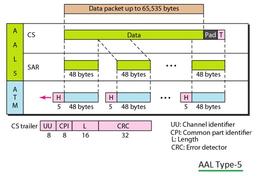SVC vs. PVC: Switched vs. Permanent Virtual Circuits
Advertisement
This article compares Switched Virtual Circuits (SVCs) and Permanent Virtual Circuits (PVCs), focusing on their differences within ATM/Frame Relay-based networks. Understanding these concepts is key to grasping ATM network architecture and its associated protocols.
Virtual Circuits Explained
A Virtual Circuit is established between two communication stations at the beginning of a data exchange using packet switching. This circuit provides a bi-directional communication path between two DTEs (Data Terminal Equipment) or between a DTE and a DCE (Data Communication Equipment). Each path within the virtual circuit is identified by a unique DLCI (Data Link Connection Identifier).
Multiple virtual circuits can be multiplexed onto a single physical circuit connection to optimize network transmission. This approach reduces network complexity and minimizes the cost of network equipment.
SVC - Switched Virtual Circuit

Switched Virtual Circuit illustration
Switched Virtual Circuits (SVCs) are temporary connections, created specifically for information transfer. Establishing an SVC connection involves four distinct stages:
- Call Setup: Initiating the connection.
- Data Transfer: Transmitting the data.
- Idle: A period of inactivity.
- Call Termination: Disconnecting the circuit.
Once an SVC is terminated, it must be re-established to transmit any further data. Because SVCs are not continuously active, the service cost is typically lower. They are established on an as-needed basis, only when data requires transmission.
PVC - Permanent Virtual Circuit
Permanent Virtual Circuits (PVCs) are permanent connections, designed for frequent and consistent data transfer. They are similar to leased lines, as they don’t require call setup or termination procedures. A PVC exists in one of two states:
- Data Transfer Mode: Data is actively transmitted between the two DTE devices over the pre-established virtual circuit path.
- Idle Mode: The connection between the DTEs remains available, but no data is being transferred.
Unlike SVCs, PVCs remain active even during idle periods. This permanent nature of PVC connections allows for immediate data transfer whenever it is ready to be sent.
Key Differences Summarized
| Feature | SVC (Switched Virtual Circuit) | PVC (Permanent Virtual Circuit) |
|---|---|---|
| Connection Type | Temporary | Permanent |
| Setup/Teardown | Requires call setup and termination | No setup or termination required |
| Usage | Infrequent data transfer | Frequent, consistent data transfer |
| Cost | Generally lower | Generally higher |
| Idle State | Circuit is terminated | Circuit remains active |
Advertisement
 RF
RF





